Dilemmas and Challenges faced by Disabled People
VerifiedAdded on 2022/08/12
|13
|3695
|16
AI Summary
Hi i have attached the assessment requirements and example, please write an assignment with 2500 words
Contribute Materials
Your contribution can guide someone’s learning journey. Share your
documents today.

Running head: DILEMMAS AND CHALLENGES
DILEMMAS AND CHALLENGES: A RESEARCH BASED ANALYSIS OF THE
EMPLOYMENT BARRIERS FACED BY DISABLED PEOPLE FROM ASYLUM
SEEKERS BACKGROUND IN AUSTRALIA
Name of the Student:
Name of the University:
Author’s Note:
DILEMMAS AND CHALLENGES: A RESEARCH BASED ANALYSIS OF THE
EMPLOYMENT BARRIERS FACED BY DISABLED PEOPLE FROM ASYLUM
SEEKERS BACKGROUND IN AUSTRALIA
Name of the Student:
Name of the University:
Author’s Note:
Secure Best Marks with AI Grader
Need help grading? Try our AI Grader for instant feedback on your assignments.
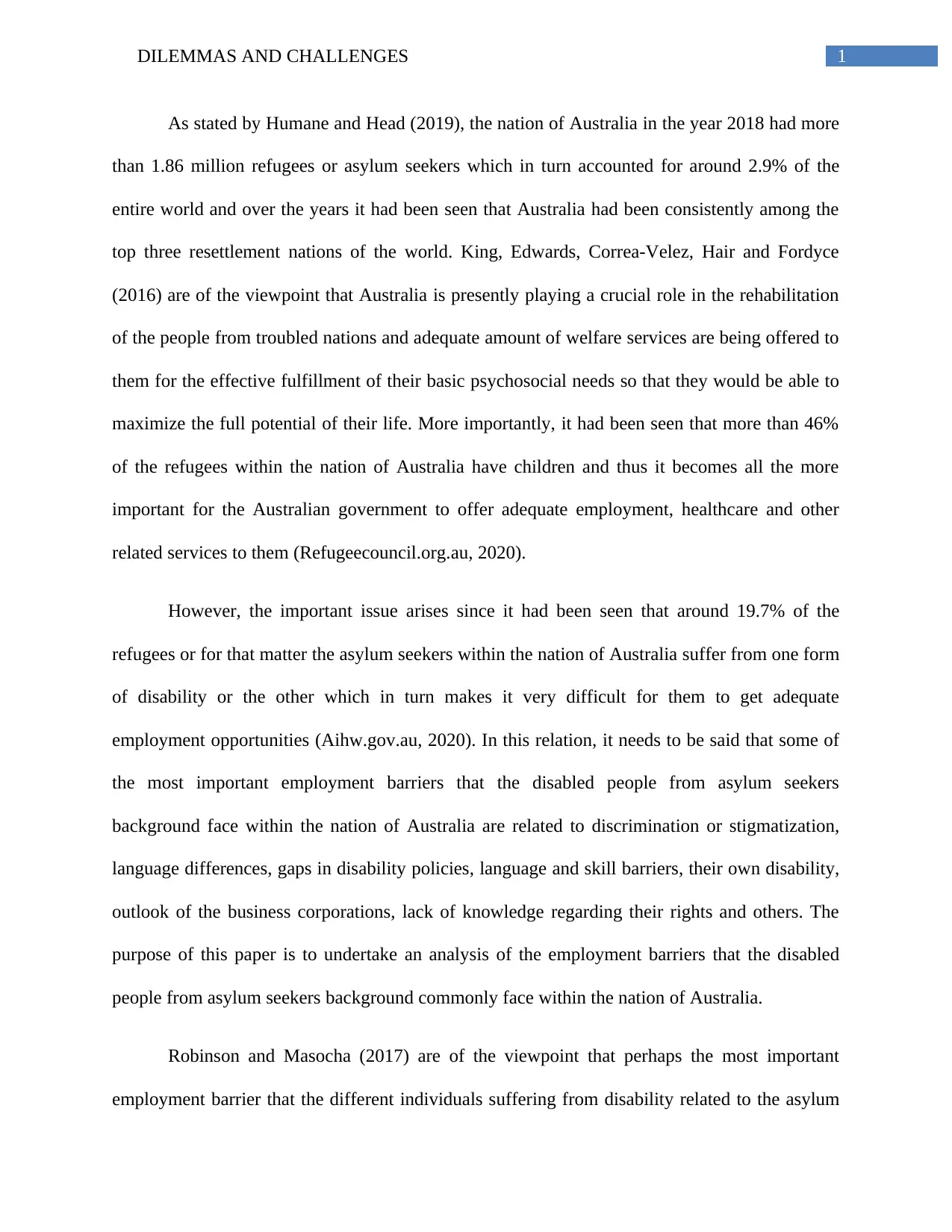
1DILEMMAS AND CHALLENGES
As stated by Humane and Head (2019), the nation of Australia in the year 2018 had more
than 1.86 million refugees or asylum seekers which in turn accounted for around 2.9% of the
entire world and over the years it had been seen that Australia had been consistently among the
top three resettlement nations of the world. King, Edwards, Correa-Velez, Hair and Fordyce
(2016) are of the viewpoint that Australia is presently playing a crucial role in the rehabilitation
of the people from troubled nations and adequate amount of welfare services are being offered to
them for the effective fulfillment of their basic psychosocial needs so that they would be able to
maximize the full potential of their life. More importantly, it had been seen that more than 46%
of the refugees within the nation of Australia have children and thus it becomes all the more
important for the Australian government to offer adequate employment, healthcare and other
related services to them (Refugeecouncil.org.au, 2020).
However, the important issue arises since it had been seen that around 19.7% of the
refugees or for that matter the asylum seekers within the nation of Australia suffer from one form
of disability or the other which in turn makes it very difficult for them to get adequate
employment opportunities (Aihw.gov.au, 2020). In this relation, it needs to be said that some of
the most important employment barriers that the disabled people from asylum seekers
background face within the nation of Australia are related to discrimination or stigmatization,
language differences, gaps in disability policies, language and skill barriers, their own disability,
outlook of the business corporations, lack of knowledge regarding their rights and others. The
purpose of this paper is to undertake an analysis of the employment barriers that the disabled
people from asylum seekers background commonly face within the nation of Australia.
Robinson and Masocha (2017) are of the viewpoint that perhaps the most important
employment barrier that the different individuals suffering from disability related to the asylum
As stated by Humane and Head (2019), the nation of Australia in the year 2018 had more
than 1.86 million refugees or asylum seekers which in turn accounted for around 2.9% of the
entire world and over the years it had been seen that Australia had been consistently among the
top three resettlement nations of the world. King, Edwards, Correa-Velez, Hair and Fordyce
(2016) are of the viewpoint that Australia is presently playing a crucial role in the rehabilitation
of the people from troubled nations and adequate amount of welfare services are being offered to
them for the effective fulfillment of their basic psychosocial needs so that they would be able to
maximize the full potential of their life. More importantly, it had been seen that more than 46%
of the refugees within the nation of Australia have children and thus it becomes all the more
important for the Australian government to offer adequate employment, healthcare and other
related services to them (Refugeecouncil.org.au, 2020).
However, the important issue arises since it had been seen that around 19.7% of the
refugees or for that matter the asylum seekers within the nation of Australia suffer from one form
of disability or the other which in turn makes it very difficult for them to get adequate
employment opportunities (Aihw.gov.au, 2020). In this relation, it needs to be said that some of
the most important employment barriers that the disabled people from asylum seekers
background face within the nation of Australia are related to discrimination or stigmatization,
language differences, gaps in disability policies, language and skill barriers, their own disability,
outlook of the business corporations, lack of knowledge regarding their rights and others. The
purpose of this paper is to undertake an analysis of the employment barriers that the disabled
people from asylum seekers background commonly face within the nation of Australia.
Robinson and Masocha (2017) are of the viewpoint that perhaps the most important
employment barrier that the different individuals suffering from disability related to the asylum
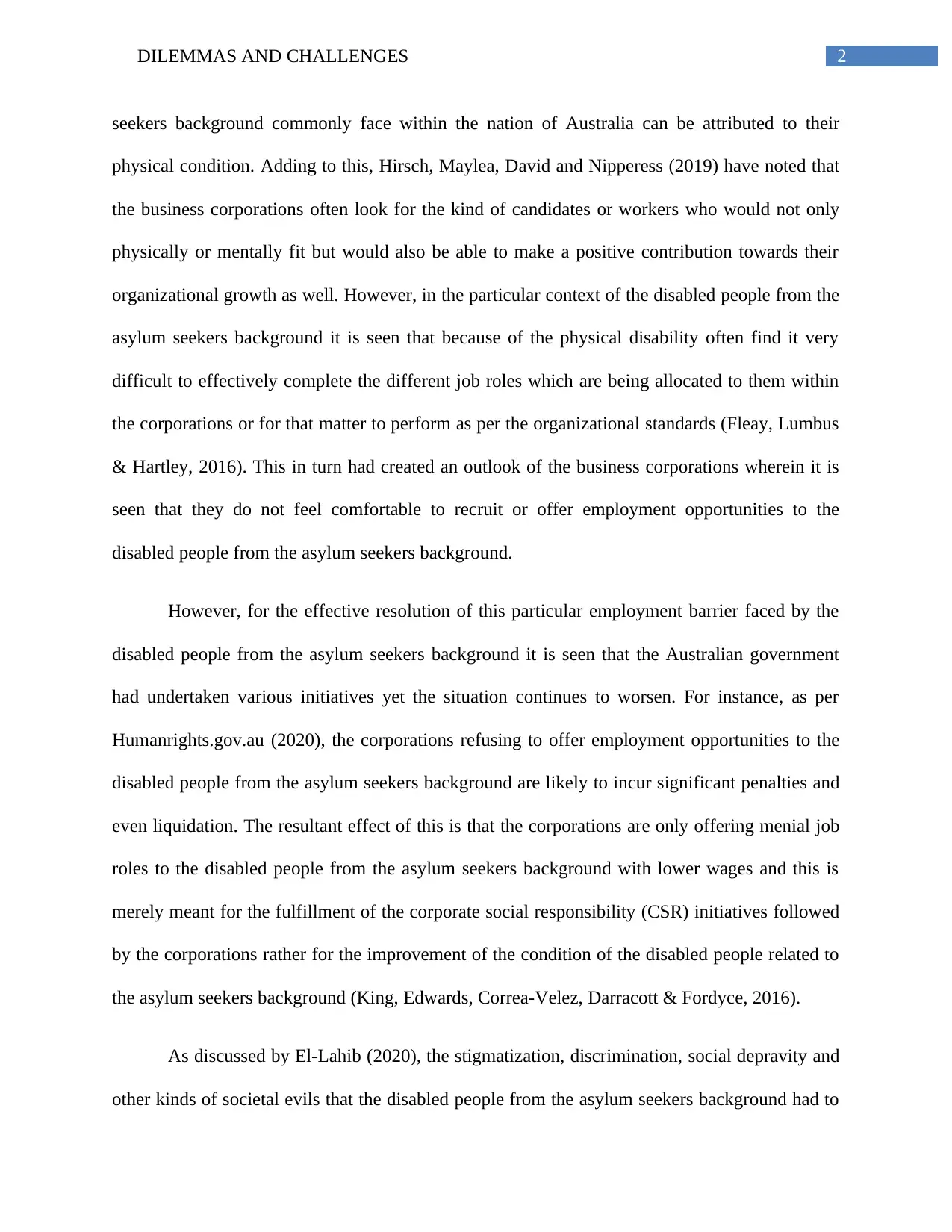
2DILEMMAS AND CHALLENGES
seekers background commonly face within the nation of Australia can be attributed to their
physical condition. Adding to this, Hirsch, Maylea, David and Nipperess (2019) have noted that
the business corporations often look for the kind of candidates or workers who would not only
physically or mentally fit but would also be able to make a positive contribution towards their
organizational growth as well. However, in the particular context of the disabled people from the
asylum seekers background it is seen that because of the physical disability often find it very
difficult to effectively complete the different job roles which are being allocated to them within
the corporations or for that matter to perform as per the organizational standards (Fleay, Lumbus
& Hartley, 2016). This in turn had created an outlook of the business corporations wherein it is
seen that they do not feel comfortable to recruit or offer employment opportunities to the
disabled people from the asylum seekers background.
However, for the effective resolution of this particular employment barrier faced by the
disabled people from the asylum seekers background it is seen that the Australian government
had undertaken various initiatives yet the situation continues to worsen. For instance, as per
Humanrights.gov.au (2020), the corporations refusing to offer employment opportunities to the
disabled people from the asylum seekers background are likely to incur significant penalties and
even liquidation. The resultant effect of this is that the corporations are only offering menial job
roles to the disabled people from the asylum seekers background with lower wages and this is
merely meant for the fulfillment of the corporate social responsibility (CSR) initiatives followed
by the corporations rather for the improvement of the condition of the disabled people related to
the asylum seekers background (King, Edwards, Correa-Velez, Darracott & Fordyce, 2016).
As discussed by El-Lahib (2020), the stigmatization, discrimination, social depravity and
other kinds of societal evils that the disabled people from the asylum seekers background had to
seekers background commonly face within the nation of Australia can be attributed to their
physical condition. Adding to this, Hirsch, Maylea, David and Nipperess (2019) have noted that
the business corporations often look for the kind of candidates or workers who would not only
physically or mentally fit but would also be able to make a positive contribution towards their
organizational growth as well. However, in the particular context of the disabled people from the
asylum seekers background it is seen that because of the physical disability often find it very
difficult to effectively complete the different job roles which are being allocated to them within
the corporations or for that matter to perform as per the organizational standards (Fleay, Lumbus
& Hartley, 2016). This in turn had created an outlook of the business corporations wherein it is
seen that they do not feel comfortable to recruit or offer employment opportunities to the
disabled people from the asylum seekers background.
However, for the effective resolution of this particular employment barrier faced by the
disabled people from the asylum seekers background it is seen that the Australian government
had undertaken various initiatives yet the situation continues to worsen. For instance, as per
Humanrights.gov.au (2020), the corporations refusing to offer employment opportunities to the
disabled people from the asylum seekers background are likely to incur significant penalties and
even liquidation. The resultant effect of this is that the corporations are only offering menial job
roles to the disabled people from the asylum seekers background with lower wages and this is
merely meant for the fulfillment of the corporate social responsibility (CSR) initiatives followed
by the corporations rather for the improvement of the condition of the disabled people related to
the asylum seekers background (King, Edwards, Correa-Velez, Darracott & Fordyce, 2016).
As discussed by El-Lahib (2020), the stigmatization, discrimination, social depravity and
other kinds of societal evils that the disabled people from the asylum seekers background had to
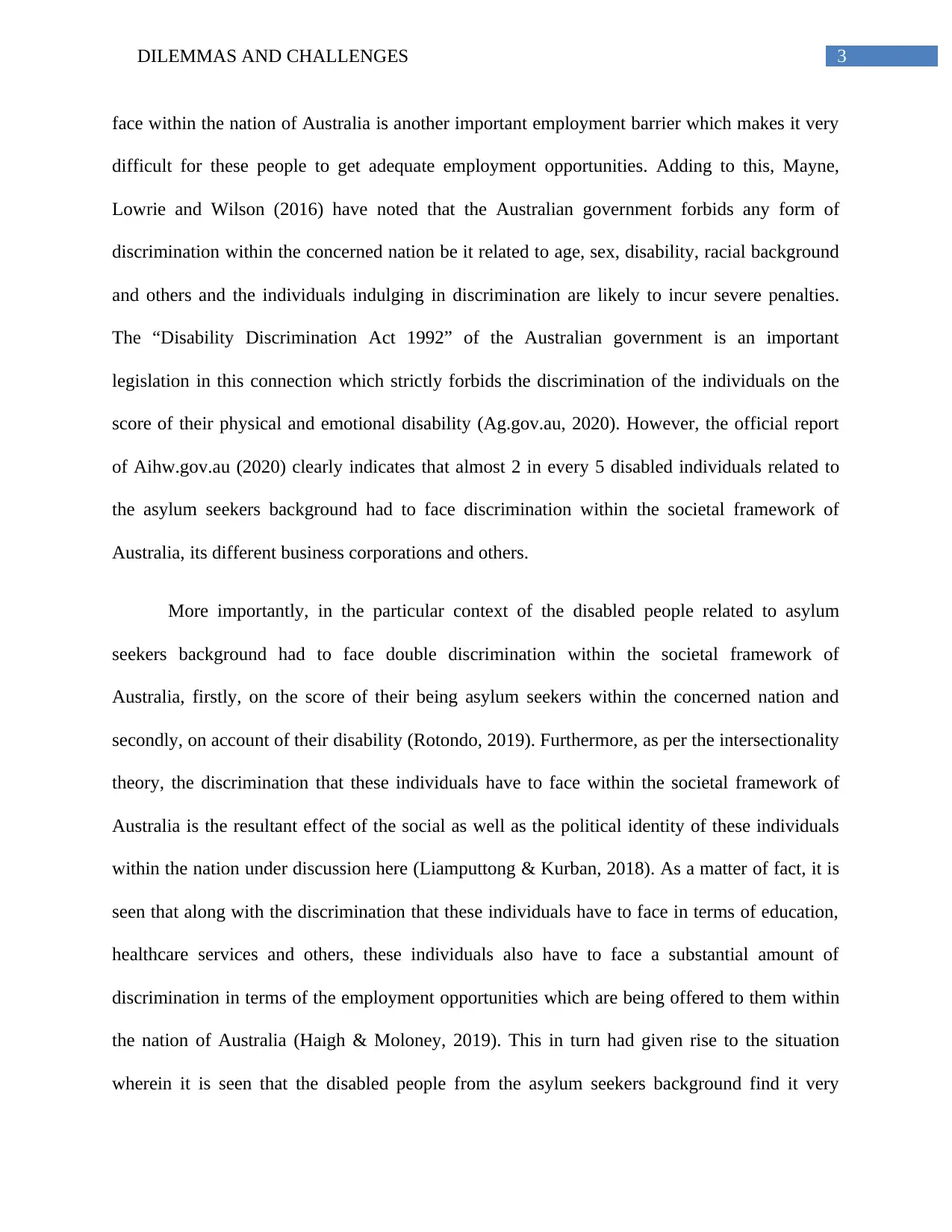
3DILEMMAS AND CHALLENGES
face within the nation of Australia is another important employment barrier which makes it very
difficult for these people to get adequate employment opportunities. Adding to this, Mayne,
Lowrie and Wilson (2016) have noted that the Australian government forbids any form of
discrimination within the concerned nation be it related to age, sex, disability, racial background
and others and the individuals indulging in discrimination are likely to incur severe penalties.
The “Disability Discrimination Act 1992” of the Australian government is an important
legislation in this connection which strictly forbids the discrimination of the individuals on the
score of their physical and emotional disability (Ag.gov.au, 2020). However, the official report
of Aihw.gov.au (2020) clearly indicates that almost 2 in every 5 disabled individuals related to
the asylum seekers background had to face discrimination within the societal framework of
Australia, its different business corporations and others.
More importantly, in the particular context of the disabled people related to asylum
seekers background had to face double discrimination within the societal framework of
Australia, firstly, on the score of their being asylum seekers within the concerned nation and
secondly, on account of their disability (Rotondo, 2019). Furthermore, as per the intersectionality
theory, the discrimination that these individuals have to face within the societal framework of
Australia is the resultant effect of the social as well as the political identity of these individuals
within the nation under discussion here (Liamputtong & Kurban, 2018). As a matter of fact, it is
seen that along with the discrimination that these individuals have to face in terms of education,
healthcare services and others, these individuals also have to face a substantial amount of
discrimination in terms of the employment opportunities which are being offered to them within
the nation of Australia (Haigh & Moloney, 2019). This in turn had given rise to the situation
wherein it is seen that the disabled people from the asylum seekers background find it very
face within the nation of Australia is another important employment barrier which makes it very
difficult for these people to get adequate employment opportunities. Adding to this, Mayne,
Lowrie and Wilson (2016) have noted that the Australian government forbids any form of
discrimination within the concerned nation be it related to age, sex, disability, racial background
and others and the individuals indulging in discrimination are likely to incur severe penalties.
The “Disability Discrimination Act 1992” of the Australian government is an important
legislation in this connection which strictly forbids the discrimination of the individuals on the
score of their physical and emotional disability (Ag.gov.au, 2020). However, the official report
of Aihw.gov.au (2020) clearly indicates that almost 2 in every 5 disabled individuals related to
the asylum seekers background had to face discrimination within the societal framework of
Australia, its different business corporations and others.
More importantly, in the particular context of the disabled people related to asylum
seekers background had to face double discrimination within the societal framework of
Australia, firstly, on the score of their being asylum seekers within the concerned nation and
secondly, on account of their disability (Rotondo, 2019). Furthermore, as per the intersectionality
theory, the discrimination that these individuals have to face within the societal framework of
Australia is the resultant effect of the social as well as the political identity of these individuals
within the nation under discussion here (Liamputtong & Kurban, 2018). As a matter of fact, it is
seen that along with the discrimination that these individuals have to face in terms of education,
healthcare services and others, these individuals also have to face a substantial amount of
discrimination in terms of the employment opportunities which are being offered to them within
the nation of Australia (Haigh & Moloney, 2019). This in turn had given rise to the situation
wherein it is seen that the disabled people from the asylum seekers background find it very
Secure Best Marks with AI Grader
Need help grading? Try our AI Grader for instant feedback on your assignments.
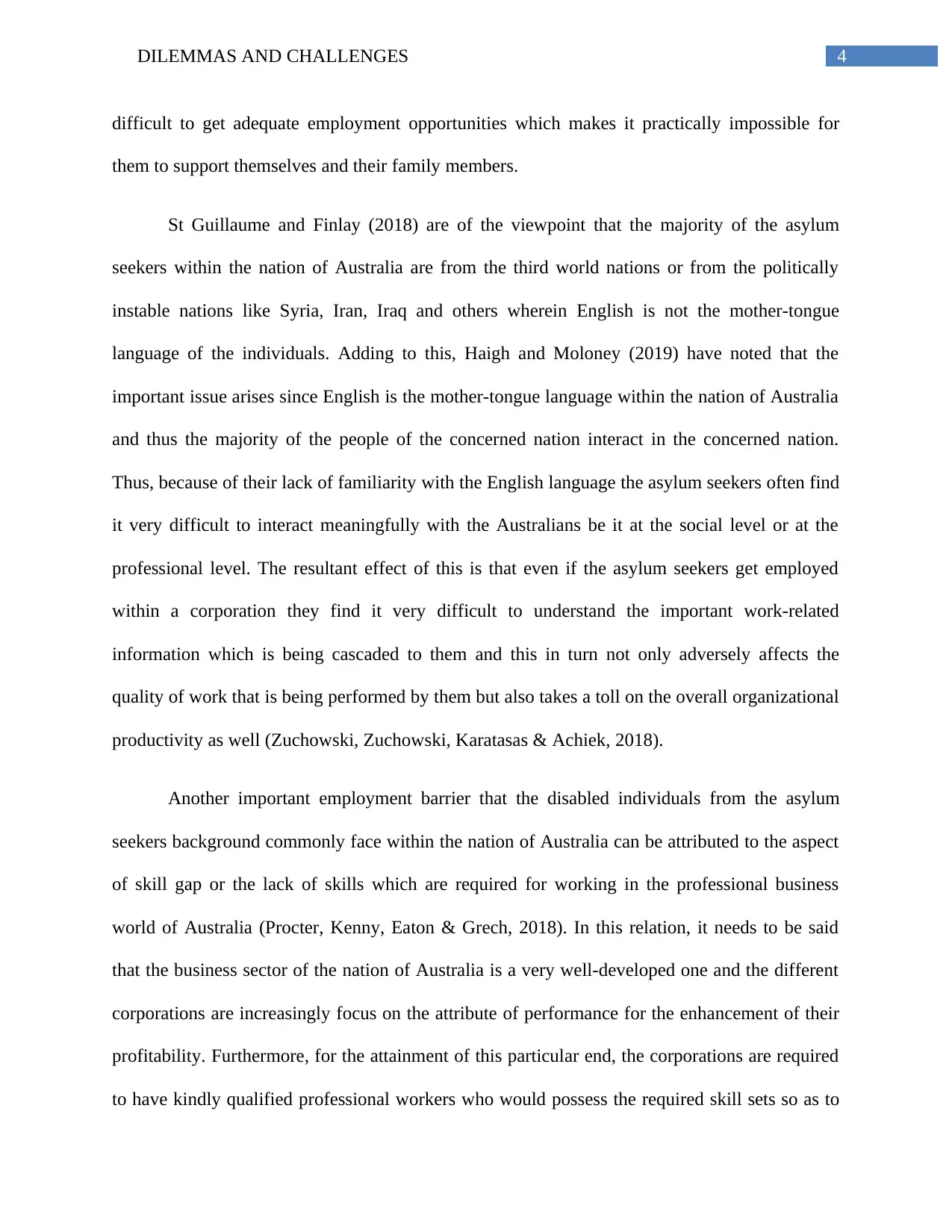
4DILEMMAS AND CHALLENGES
difficult to get adequate employment opportunities which makes it practically impossible for
them to support themselves and their family members.
St Guillaume and Finlay (2018) are of the viewpoint that the majority of the asylum
seekers within the nation of Australia are from the third world nations or from the politically
instable nations like Syria, Iran, Iraq and others wherein English is not the mother-tongue
language of the individuals. Adding to this, Haigh and Moloney (2019) have noted that the
important issue arises since English is the mother-tongue language within the nation of Australia
and thus the majority of the people of the concerned nation interact in the concerned nation.
Thus, because of their lack of familiarity with the English language the asylum seekers often find
it very difficult to interact meaningfully with the Australians be it at the social level or at the
professional level. The resultant effect of this is that even if the asylum seekers get employed
within a corporation they find it very difficult to understand the important work-related
information which is being cascaded to them and this in turn not only adversely affects the
quality of work that is being performed by them but also takes a toll on the overall organizational
productivity as well (Zuchowski, Zuchowski, Karatasas & Achiek, 2018).
Another important employment barrier that the disabled individuals from the asylum
seekers background commonly face within the nation of Australia can be attributed to the aspect
of skill gap or the lack of skills which are required for working in the professional business
world of Australia (Procter, Kenny, Eaton & Grech, 2018). In this relation, it needs to be said
that the business sector of the nation of Australia is a very well-developed one and the different
corporations are increasingly focus on the attribute of performance for the enhancement of their
profitability. Furthermore, for the attainment of this particular end, the corporations are required
to have kindly qualified professional workers who would possess the required skill sets so as to
difficult to get adequate employment opportunities which makes it practically impossible for
them to support themselves and their family members.
St Guillaume and Finlay (2018) are of the viewpoint that the majority of the asylum
seekers within the nation of Australia are from the third world nations or from the politically
instable nations like Syria, Iran, Iraq and others wherein English is not the mother-tongue
language of the individuals. Adding to this, Haigh and Moloney (2019) have noted that the
important issue arises since English is the mother-tongue language within the nation of Australia
and thus the majority of the people of the concerned nation interact in the concerned nation.
Thus, because of their lack of familiarity with the English language the asylum seekers often find
it very difficult to interact meaningfully with the Australians be it at the social level or at the
professional level. The resultant effect of this is that even if the asylum seekers get employed
within a corporation they find it very difficult to understand the important work-related
information which is being cascaded to them and this in turn not only adversely affects the
quality of work that is being performed by them but also takes a toll on the overall organizational
productivity as well (Zuchowski, Zuchowski, Karatasas & Achiek, 2018).
Another important employment barrier that the disabled individuals from the asylum
seekers background commonly face within the nation of Australia can be attributed to the aspect
of skill gap or the lack of skills which are required for working in the professional business
world of Australia (Procter, Kenny, Eaton & Grech, 2018). In this relation, it needs to be said
that the business sector of the nation of Australia is a very well-developed one and the different
corporations are increasingly focus on the attribute of performance for the enhancement of their
profitability. Furthermore, for the attainment of this particular end, the corporations are required
to have kindly qualified professional workers who would possess the required skill sets so as to

5DILEMMAS AND CHALLENGES
be able to perform as per the performance standards or for that matter the expectations of the
organizations (Thoresen, Thomson, Jackson & Cocks, 2018). However, in the particular context
of the disabled people from the asylum seekers background it is seen that not only these
individuals do not possess the required educational qualifications nor do they have the skill sets
for performing as per the expectations of the organizations (Rotondo, 2019). This in turn is
another important employment barrier that the different disabled people from the asylum seekers
background face within the nation of Australia which in turn makes it very difficult for them to
get employment within the concerned nation.
As discussed by Harris, Owen and Fisher (2016), an important employment barrier which
the disabled people from the asylum seekers background commonly face within the nation of
Australia related to the aspect of getting suitable employment opportunities can be attributed to
the gaps in the diversity as well as the disability policies of the concerned nation. Thoresen,
Thomson, Jackson and Cocks (2018) are of the viewpoint that the majority of the disabled people
from the asylum seekers are not even aware of their basic employment, healthcare, educational
and other kinds of rights which are being offered to them by the Australian government. Thus, it
had been seen that in the absence of working knowledge regarding their rights, the disabled
people from the asylum seekers background fail to take advantage of the same and this in turn
had aggravated their situation even further within the nation under discussion here. More
importantly, it had been seen that different kinds of services are being offered by the Australian
government to the disabled people from the asylum seekers background like “National Disability
Insurance Scheme (NDIS)”, services offered by the Refugee Council of Australia (RCOA) and
others which are intended to help the people suffering from disability in the best possible manner
(Refugeecouncil.org.au, 2020).
be able to perform as per the performance standards or for that matter the expectations of the
organizations (Thoresen, Thomson, Jackson & Cocks, 2018). However, in the particular context
of the disabled people from the asylum seekers background it is seen that not only these
individuals do not possess the required educational qualifications nor do they have the skill sets
for performing as per the expectations of the organizations (Rotondo, 2019). This in turn is
another important employment barrier that the different disabled people from the asylum seekers
background face within the nation of Australia which in turn makes it very difficult for them to
get employment within the concerned nation.
As discussed by Harris, Owen and Fisher (2016), an important employment barrier which
the disabled people from the asylum seekers background commonly face within the nation of
Australia related to the aspect of getting suitable employment opportunities can be attributed to
the gaps in the diversity as well as the disability policies of the concerned nation. Thoresen,
Thomson, Jackson and Cocks (2018) are of the viewpoint that the majority of the disabled people
from the asylum seekers are not even aware of their basic employment, healthcare, educational
and other kinds of rights which are being offered to them by the Australian government. Thus, it
had been seen that in the absence of working knowledge regarding their rights, the disabled
people from the asylum seekers background fail to take advantage of the same and this in turn
had aggravated their situation even further within the nation under discussion here. More
importantly, it had been seen that different kinds of services are being offered by the Australian
government to the disabled people from the asylum seekers background like “National Disability
Insurance Scheme (NDIS)”, services offered by the Refugee Council of Australia (RCOA) and
others which are intended to help the people suffering from disability in the best possible manner
(Refugeecouncil.org.au, 2020).
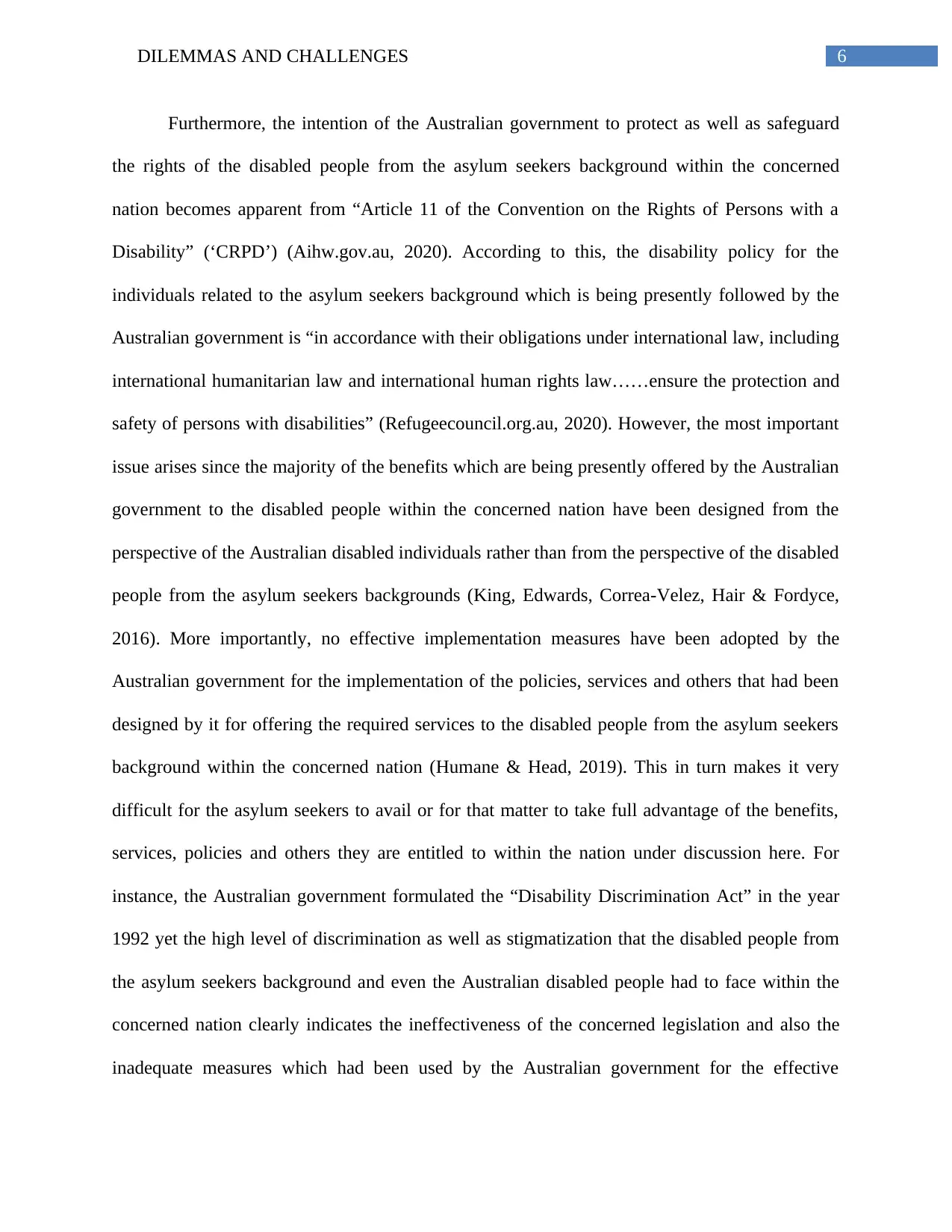
6DILEMMAS AND CHALLENGES
Furthermore, the intention of the Australian government to protect as well as safeguard
the rights of the disabled people from the asylum seekers background within the concerned
nation becomes apparent from “Article 11 of the Convention on the Rights of Persons with a
Disability” (‘CRPD’) (Aihw.gov.au, 2020). According to this, the disability policy for the
individuals related to the asylum seekers background which is being presently followed by the
Australian government is “in accordance with their obligations under international law, including
international humanitarian law and international human rights law……ensure the protection and
safety of persons with disabilities” (Refugeecouncil.org.au, 2020). However, the most important
issue arises since the majority of the benefits which are being presently offered by the Australian
government to the disabled people within the concerned nation have been designed from the
perspective of the Australian disabled individuals rather than from the perspective of the disabled
people from the asylum seekers backgrounds (King, Edwards, Correa-Velez, Hair & Fordyce,
2016). More importantly, no effective implementation measures have been adopted by the
Australian government for the implementation of the policies, services and others that had been
designed by it for offering the required services to the disabled people from the asylum seekers
background within the concerned nation (Humane & Head, 2019). This in turn makes it very
difficult for the asylum seekers to avail or for that matter to take full advantage of the benefits,
services, policies and others they are entitled to within the nation under discussion here. For
instance, the Australian government formulated the “Disability Discrimination Act” in the year
1992 yet the high level of discrimination as well as stigmatization that the disabled people from
the asylum seekers background and even the Australian disabled people had to face within the
concerned nation clearly indicates the ineffectiveness of the concerned legislation and also the
inadequate measures which had been used by the Australian government for the effective
Furthermore, the intention of the Australian government to protect as well as safeguard
the rights of the disabled people from the asylum seekers background within the concerned
nation becomes apparent from “Article 11 of the Convention on the Rights of Persons with a
Disability” (‘CRPD’) (Aihw.gov.au, 2020). According to this, the disability policy for the
individuals related to the asylum seekers background which is being presently followed by the
Australian government is “in accordance with their obligations under international law, including
international humanitarian law and international human rights law……ensure the protection and
safety of persons with disabilities” (Refugeecouncil.org.au, 2020). However, the most important
issue arises since the majority of the benefits which are being presently offered by the Australian
government to the disabled people within the concerned nation have been designed from the
perspective of the Australian disabled individuals rather than from the perspective of the disabled
people from the asylum seekers backgrounds (King, Edwards, Correa-Velez, Hair & Fordyce,
2016). More importantly, no effective implementation measures have been adopted by the
Australian government for the implementation of the policies, services and others that had been
designed by it for offering the required services to the disabled people from the asylum seekers
background within the concerned nation (Humane & Head, 2019). This in turn makes it very
difficult for the asylum seekers to avail or for that matter to take full advantage of the benefits,
services, policies and others they are entitled to within the nation under discussion here. For
instance, the Australian government formulated the “Disability Discrimination Act” in the year
1992 yet the high level of discrimination as well as stigmatization that the disabled people from
the asylum seekers background and even the Australian disabled people had to face within the
concerned nation clearly indicates the ineffectiveness of the concerned legislation and also the
inadequate measures which had been used by the Australian government for the effective
Paraphrase This Document
Need a fresh take? Get an instant paraphrase of this document with our AI Paraphraser
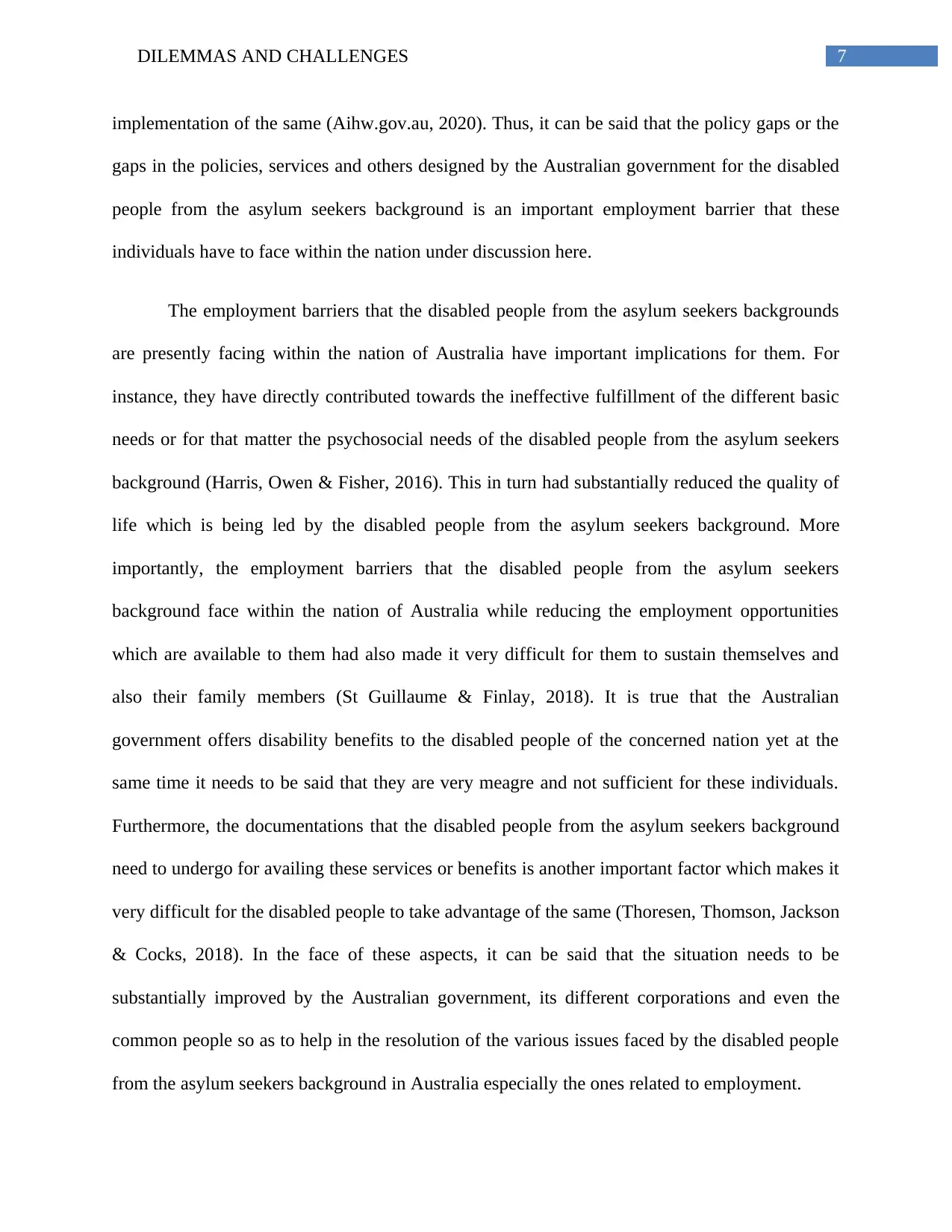
7DILEMMAS AND CHALLENGES
implementation of the same (Aihw.gov.au, 2020). Thus, it can be said that the policy gaps or the
gaps in the policies, services and others designed by the Australian government for the disabled
people from the asylum seekers background is an important employment barrier that these
individuals have to face within the nation under discussion here.
The employment barriers that the disabled people from the asylum seekers backgrounds
are presently facing within the nation of Australia have important implications for them. For
instance, they have directly contributed towards the ineffective fulfillment of the different basic
needs or for that matter the psychosocial needs of the disabled people from the asylum seekers
background (Harris, Owen & Fisher, 2016). This in turn had substantially reduced the quality of
life which is being led by the disabled people from the asylum seekers background. More
importantly, the employment barriers that the disabled people from the asylum seekers
background face within the nation of Australia while reducing the employment opportunities
which are available to them had also made it very difficult for them to sustain themselves and
also their family members (St Guillaume & Finlay, 2018). It is true that the Australian
government offers disability benefits to the disabled people of the concerned nation yet at the
same time it needs to be said that they are very meagre and not sufficient for these individuals.
Furthermore, the documentations that the disabled people from the asylum seekers background
need to undergo for availing these services or benefits is another important factor which makes it
very difficult for the disabled people to take advantage of the same (Thoresen, Thomson, Jackson
& Cocks, 2018). In the face of these aspects, it can be said that the situation needs to be
substantially improved by the Australian government, its different corporations and even the
common people so as to help in the resolution of the various issues faced by the disabled people
from the asylum seekers background in Australia especially the ones related to employment.
implementation of the same (Aihw.gov.au, 2020). Thus, it can be said that the policy gaps or the
gaps in the policies, services and others designed by the Australian government for the disabled
people from the asylum seekers background is an important employment barrier that these
individuals have to face within the nation under discussion here.
The employment barriers that the disabled people from the asylum seekers backgrounds
are presently facing within the nation of Australia have important implications for them. For
instance, they have directly contributed towards the ineffective fulfillment of the different basic
needs or for that matter the psychosocial needs of the disabled people from the asylum seekers
background (Harris, Owen & Fisher, 2016). This in turn had substantially reduced the quality of
life which is being led by the disabled people from the asylum seekers background. More
importantly, the employment barriers that the disabled people from the asylum seekers
background face within the nation of Australia while reducing the employment opportunities
which are available to them had also made it very difficult for them to sustain themselves and
also their family members (St Guillaume & Finlay, 2018). It is true that the Australian
government offers disability benefits to the disabled people of the concerned nation yet at the
same time it needs to be said that they are very meagre and not sufficient for these individuals.
Furthermore, the documentations that the disabled people from the asylum seekers background
need to undergo for availing these services or benefits is another important factor which makes it
very difficult for the disabled people to take advantage of the same (Thoresen, Thomson, Jackson
& Cocks, 2018). In the face of these aspects, it can be said that the situation needs to be
substantially improved by the Australian government, its different corporations and even the
common people so as to help in the resolution of the various issues faced by the disabled people
from the asylum seekers background in Australia especially the ones related to employment.
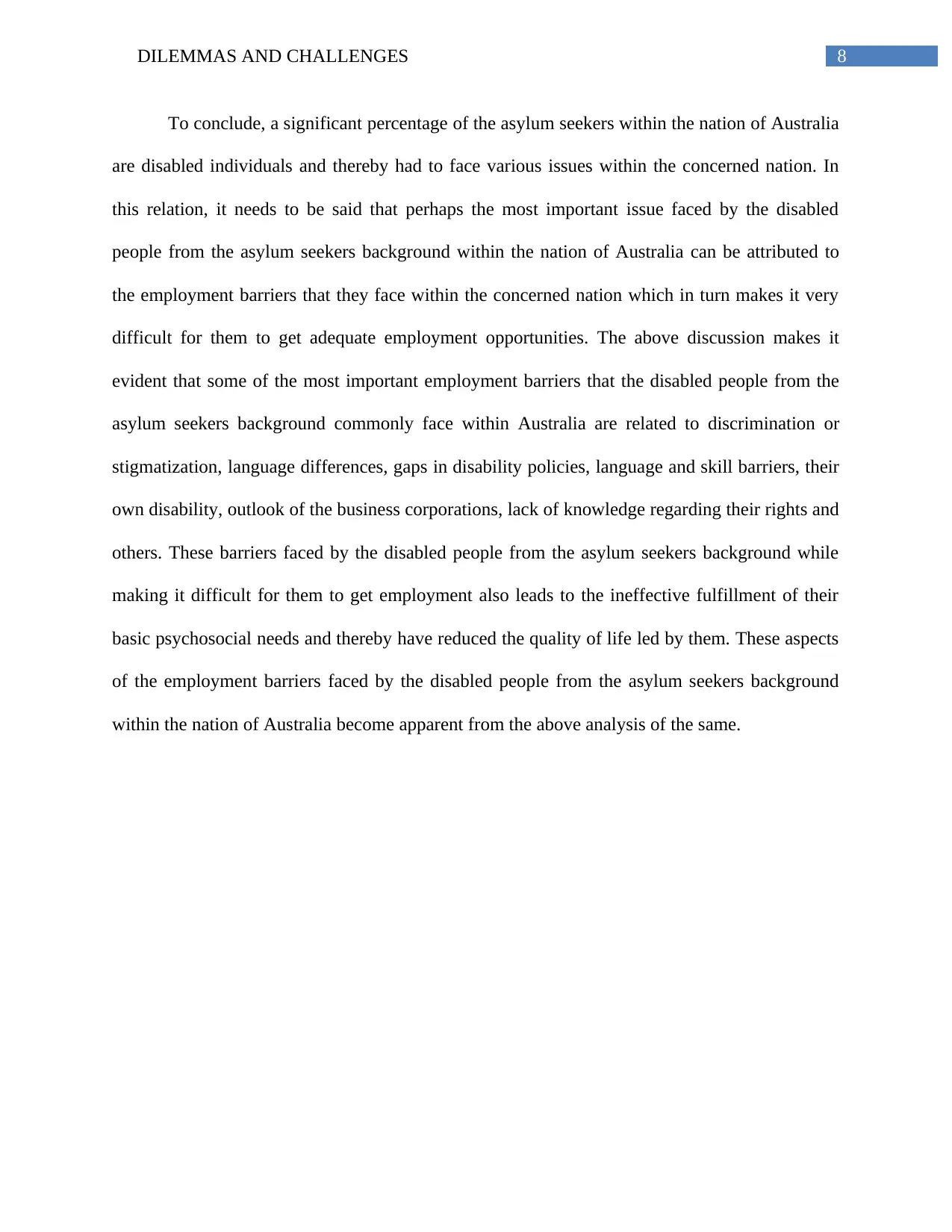
8DILEMMAS AND CHALLENGES
To conclude, a significant percentage of the asylum seekers within the nation of Australia
are disabled individuals and thereby had to face various issues within the concerned nation. In
this relation, it needs to be said that perhaps the most important issue faced by the disabled
people from the asylum seekers background within the nation of Australia can be attributed to
the employment barriers that they face within the concerned nation which in turn makes it very
difficult for them to get adequate employment opportunities. The above discussion makes it
evident that some of the most important employment barriers that the disabled people from the
asylum seekers background commonly face within Australia are related to discrimination or
stigmatization, language differences, gaps in disability policies, language and skill barriers, their
own disability, outlook of the business corporations, lack of knowledge regarding their rights and
others. These barriers faced by the disabled people from the asylum seekers background while
making it difficult for them to get employment also leads to the ineffective fulfillment of their
basic psychosocial needs and thereby have reduced the quality of life led by them. These aspects
of the employment barriers faced by the disabled people from the asylum seekers background
within the nation of Australia become apparent from the above analysis of the same.
To conclude, a significant percentage of the asylum seekers within the nation of Australia
are disabled individuals and thereby had to face various issues within the concerned nation. In
this relation, it needs to be said that perhaps the most important issue faced by the disabled
people from the asylum seekers background within the nation of Australia can be attributed to
the employment barriers that they face within the concerned nation which in turn makes it very
difficult for them to get adequate employment opportunities. The above discussion makes it
evident that some of the most important employment barriers that the disabled people from the
asylum seekers background commonly face within Australia are related to discrimination or
stigmatization, language differences, gaps in disability policies, language and skill barriers, their
own disability, outlook of the business corporations, lack of knowledge regarding their rights and
others. These barriers faced by the disabled people from the asylum seekers background while
making it difficult for them to get employment also leads to the ineffective fulfillment of their
basic psychosocial needs and thereby have reduced the quality of life led by them. These aspects
of the employment barriers faced by the disabled people from the asylum seekers background
within the nation of Australia become apparent from the above analysis of the same.
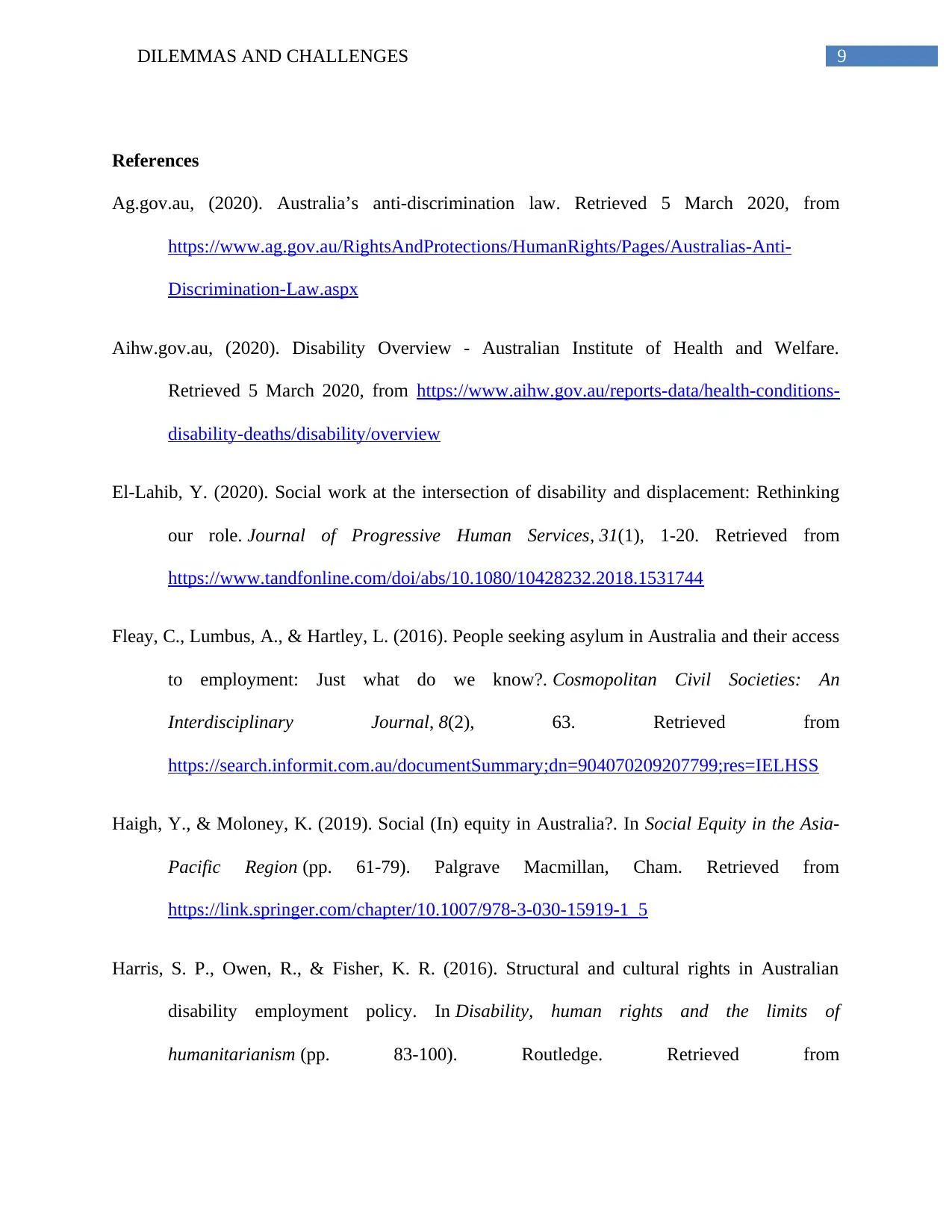
9DILEMMAS AND CHALLENGES
References
Ag.gov.au, (2020). Australia’s anti-discrimination law. Retrieved 5 March 2020, from
https://www.ag.gov.au/RightsAndProtections/HumanRights/Pages/Australias-Anti-
Discrimination-Law.aspx
Aihw.gov.au, (2020). Disability Overview - Australian Institute of Health and Welfare.
Retrieved 5 March 2020, from https://www.aihw.gov.au/reports-data/health-conditions-
disability-deaths/disability/overview
El-Lahib, Y. (2020). Social work at the intersection of disability and displacement: Rethinking
our role. Journal of Progressive Human Services, 31(1), 1-20. Retrieved from
https://www.tandfonline.com/doi/abs/10.1080/10428232.2018.1531744
Fleay, C., Lumbus, A., & Hartley, L. (2016). People seeking asylum in Australia and their access
to employment: Just what do we know?. Cosmopolitan Civil Societies: An
Interdisciplinary Journal, 8(2), 63. Retrieved from
https://search.informit.com.au/documentSummary;dn=904070209207799;res=IELHSS
Haigh, Y., & Moloney, K. (2019). Social (In) equity in Australia?. In Social Equity in the Asia-
Pacific Region (pp. 61-79). Palgrave Macmillan, Cham. Retrieved from
https://link.springer.com/chapter/10.1007/978-3-030-15919-1_5
Harris, S. P., Owen, R., & Fisher, K. R. (2016). Structural and cultural rights in Australian
disability employment policy. In Disability, human rights and the limits of
humanitarianism (pp. 83-100). Routledge. Retrieved from
References
Ag.gov.au, (2020). Australia’s anti-discrimination law. Retrieved 5 March 2020, from
https://www.ag.gov.au/RightsAndProtections/HumanRights/Pages/Australias-Anti-
Discrimination-Law.aspx
Aihw.gov.au, (2020). Disability Overview - Australian Institute of Health and Welfare.
Retrieved 5 March 2020, from https://www.aihw.gov.au/reports-data/health-conditions-
disability-deaths/disability/overview
El-Lahib, Y. (2020). Social work at the intersection of disability and displacement: Rethinking
our role. Journal of Progressive Human Services, 31(1), 1-20. Retrieved from
https://www.tandfonline.com/doi/abs/10.1080/10428232.2018.1531744
Fleay, C., Lumbus, A., & Hartley, L. (2016). People seeking asylum in Australia and their access
to employment: Just what do we know?. Cosmopolitan Civil Societies: An
Interdisciplinary Journal, 8(2), 63. Retrieved from
https://search.informit.com.au/documentSummary;dn=904070209207799;res=IELHSS
Haigh, Y., & Moloney, K. (2019). Social (In) equity in Australia?. In Social Equity in the Asia-
Pacific Region (pp. 61-79). Palgrave Macmillan, Cham. Retrieved from
https://link.springer.com/chapter/10.1007/978-3-030-15919-1_5
Harris, S. P., Owen, R., & Fisher, K. R. (2016). Structural and cultural rights in Australian
disability employment policy. In Disability, human rights and the limits of
humanitarianism (pp. 83-100). Routledge. Retrieved from
Secure Best Marks with AI Grader
Need help grading? Try our AI Grader for instant feedback on your assignments.
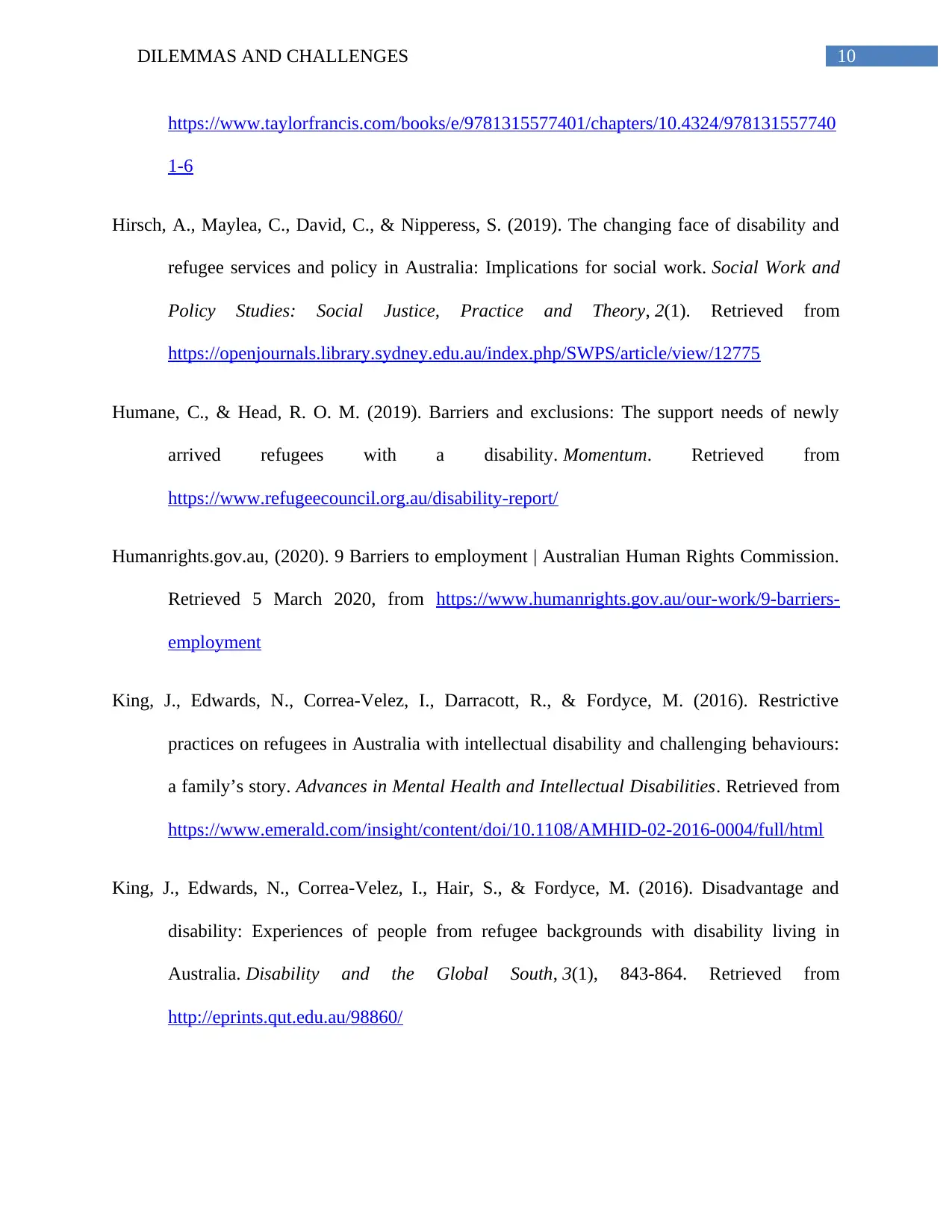
10DILEMMAS AND CHALLENGES
https://www.taylorfrancis.com/books/e/9781315577401/chapters/10.4324/978131557740
1-6
Hirsch, A., Maylea, C., David, C., & Nipperess, S. (2019). The changing face of disability and
refugee services and policy in Australia: Implications for social work. Social Work and
Policy Studies: Social Justice, Practice and Theory, 2(1). Retrieved from
https://openjournals.library.sydney.edu.au/index.php/SWPS/article/view/12775
Humane, C., & Head, R. O. M. (2019). Barriers and exclusions: The support needs of newly
arrived refugees with a disability. Momentum. Retrieved from
https://www.refugeecouncil.org.au/disability-report/
Humanrights.gov.au, (2020). 9 Barriers to employment | Australian Human Rights Commission.
Retrieved 5 March 2020, from https://www.humanrights.gov.au/our-work/9-barriers-
employment
King, J., Edwards, N., Correa-Velez, I., Darracott, R., & Fordyce, M. (2016). Restrictive
practices on refugees in Australia with intellectual disability and challenging behaviours:
a family’s story. Advances in Mental Health and Intellectual Disabilities. Retrieved from
https://www.emerald.com/insight/content/doi/10.1108/AMHID-02-2016-0004/full/html
King, J., Edwards, N., Correa-Velez, I., Hair, S., & Fordyce, M. (2016). Disadvantage and
disability: Experiences of people from refugee backgrounds with disability living in
Australia. Disability and the Global South, 3(1), 843-864. Retrieved from
http://eprints.qut.edu.au/98860/
https://www.taylorfrancis.com/books/e/9781315577401/chapters/10.4324/978131557740
1-6
Hirsch, A., Maylea, C., David, C., & Nipperess, S. (2019). The changing face of disability and
refugee services and policy in Australia: Implications for social work. Social Work and
Policy Studies: Social Justice, Practice and Theory, 2(1). Retrieved from
https://openjournals.library.sydney.edu.au/index.php/SWPS/article/view/12775
Humane, C., & Head, R. O. M. (2019). Barriers and exclusions: The support needs of newly
arrived refugees with a disability. Momentum. Retrieved from
https://www.refugeecouncil.org.au/disability-report/
Humanrights.gov.au, (2020). 9 Barriers to employment | Australian Human Rights Commission.
Retrieved 5 March 2020, from https://www.humanrights.gov.au/our-work/9-barriers-
employment
King, J., Edwards, N., Correa-Velez, I., Darracott, R., & Fordyce, M. (2016). Restrictive
practices on refugees in Australia with intellectual disability and challenging behaviours:
a family’s story. Advances in Mental Health and Intellectual Disabilities. Retrieved from
https://www.emerald.com/insight/content/doi/10.1108/AMHID-02-2016-0004/full/html
King, J., Edwards, N., Correa-Velez, I., Hair, S., & Fordyce, M. (2016). Disadvantage and
disability: Experiences of people from refugee backgrounds with disability living in
Australia. Disability and the Global South, 3(1), 843-864. Retrieved from
http://eprints.qut.edu.au/98860/

11DILEMMAS AND CHALLENGES
Liamputtong, P., & Kurban, H. (2018). Health, social integration and social support: The lived
experiences of young Middle-Eastern refugees living in Melbourne, Australia. Children
and Youth Services Review, 85, 99-106. Retrieved from
https://www.sciencedirect.com/science/article/pii/S0190740917305133
Mayne, J., Lowrie, D., & Wilson, J. (2016). Occupational experiences of refugees and asylum
seekers resettling in Australia: A narrative review. OTJR: occupation, participation and
health, 36(4), 204-215. Retrieved from
https://journals.sagepub.com/doi/abs/10.1177/1539449216668648
Procter, N. G., Kenny, M. A., Eaton, H., & Grech, C. (2018). Lethal hopelessness:
Understanding and responding to asylum seeker distress and mental
deterioration. International journal of mental health nursing, 27(1), 448-454. Retrieved
from https://onlinelibrary.wiley.com/doi/abs/10.1111/inm.12325
Refugeecouncil.org.au, (2020). Barriers and exclusions: The support needs of newly arrived
refugees with a disability-Refugee Council of Australia. Retrieved 5 March 2020, from
https://www.refugeecouncil.org.au/disability-report/16/
Rotondo, G. (2019). Refugee and Asylum Seeker Vulnerability in the Context of Resettlement:
The Role of Humanitarian Organisations in Australia and Italy. In Vulnerability in a
Mobile World. Emerald Publishing Limited. Retrieved from
https://www.emerald.com/insight/content/doi/10.1108/978-1-78756-911-920191008/
full/html
Liamputtong, P., & Kurban, H. (2018). Health, social integration and social support: The lived
experiences of young Middle-Eastern refugees living in Melbourne, Australia. Children
and Youth Services Review, 85, 99-106. Retrieved from
https://www.sciencedirect.com/science/article/pii/S0190740917305133
Mayne, J., Lowrie, D., & Wilson, J. (2016). Occupational experiences of refugees and asylum
seekers resettling in Australia: A narrative review. OTJR: occupation, participation and
health, 36(4), 204-215. Retrieved from
https://journals.sagepub.com/doi/abs/10.1177/1539449216668648
Procter, N. G., Kenny, M. A., Eaton, H., & Grech, C. (2018). Lethal hopelessness:
Understanding and responding to asylum seeker distress and mental
deterioration. International journal of mental health nursing, 27(1), 448-454. Retrieved
from https://onlinelibrary.wiley.com/doi/abs/10.1111/inm.12325
Refugeecouncil.org.au, (2020). Barriers and exclusions: The support needs of newly arrived
refugees with a disability-Refugee Council of Australia. Retrieved 5 March 2020, from
https://www.refugeecouncil.org.au/disability-report/16/
Rotondo, G. (2019). Refugee and Asylum Seeker Vulnerability in the Context of Resettlement:
The Role of Humanitarian Organisations in Australia and Italy. In Vulnerability in a
Mobile World. Emerald Publishing Limited. Retrieved from
https://www.emerald.com/insight/content/doi/10.1108/978-1-78756-911-920191008/
full/html
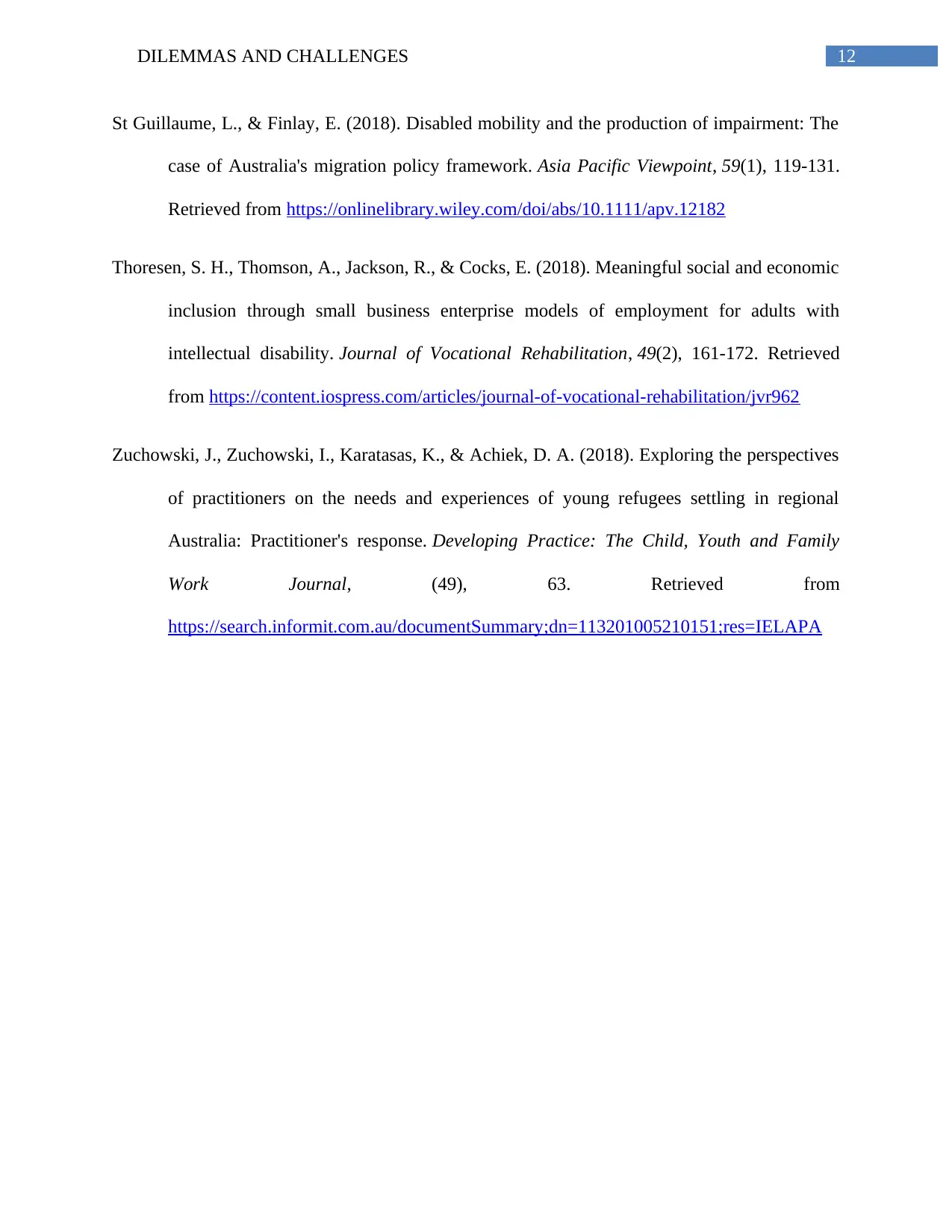
12DILEMMAS AND CHALLENGES
St Guillaume, L., & Finlay, E. (2018). Disabled mobility and the production of impairment: The
case of Australia's migration policy framework. Asia Pacific Viewpoint, 59(1), 119-131.
Retrieved from https://onlinelibrary.wiley.com/doi/abs/10.1111/apv.12182
Thoresen, S. H., Thomson, A., Jackson, R., & Cocks, E. (2018). Meaningful social and economic
inclusion through small business enterprise models of employment for adults with
intellectual disability. Journal of Vocational Rehabilitation, 49(2), 161-172. Retrieved
from https://content.iospress.com/articles/journal-of-vocational-rehabilitation/jvr962
Zuchowski, J., Zuchowski, I., Karatasas, K., & Achiek, D. A. (2018). Exploring the perspectives
of practitioners on the needs and experiences of young refugees settling in regional
Australia: Practitioner's response. Developing Practice: The Child, Youth and Family
Work Journal, (49), 63. Retrieved from
https://search.informit.com.au/documentSummary;dn=113201005210151;res=IELAPA
St Guillaume, L., & Finlay, E. (2018). Disabled mobility and the production of impairment: The
case of Australia's migration policy framework. Asia Pacific Viewpoint, 59(1), 119-131.
Retrieved from https://onlinelibrary.wiley.com/doi/abs/10.1111/apv.12182
Thoresen, S. H., Thomson, A., Jackson, R., & Cocks, E. (2018). Meaningful social and economic
inclusion through small business enterprise models of employment for adults with
intellectual disability. Journal of Vocational Rehabilitation, 49(2), 161-172. Retrieved
from https://content.iospress.com/articles/journal-of-vocational-rehabilitation/jvr962
Zuchowski, J., Zuchowski, I., Karatasas, K., & Achiek, D. A. (2018). Exploring the perspectives
of practitioners on the needs and experiences of young refugees settling in regional
Australia: Practitioner's response. Developing Practice: The Child, Youth and Family
Work Journal, (49), 63. Retrieved from
https://search.informit.com.au/documentSummary;dn=113201005210151;res=IELAPA
1 out of 13
Related Documents
Your All-in-One AI-Powered Toolkit for Academic Success.
+13062052269
info@desklib.com
Available 24*7 on WhatsApp / Email
![[object Object]](/_next/static/media/star-bottom.7253800d.svg)
Unlock your academic potential
© 2024 | Zucol Services PVT LTD | All rights reserved.





